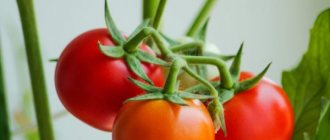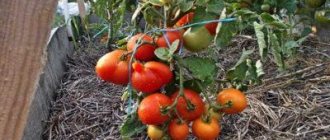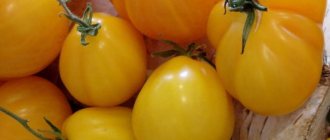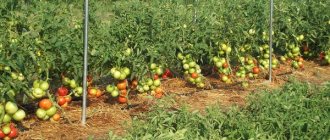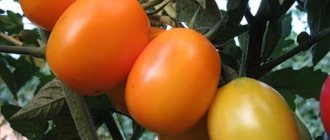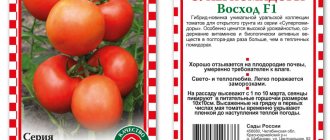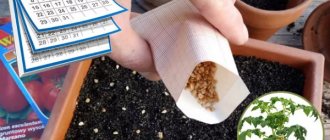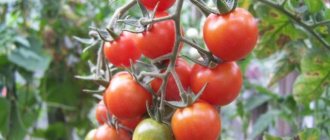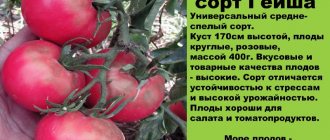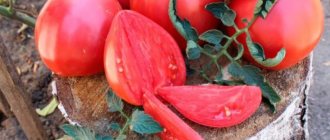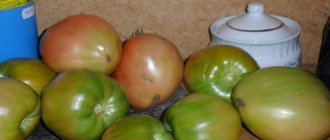Description of the variety
Honey salute has been in the State Register since 2015 (from agro).
The originator of the variety recommends growing it throughout the Russian Federation under film cover. However, the experience of many farmers has shown that the plant shows good productivity in both gardening and greenhouse conditions. The crop is tall, reaches 1.5-2 m. The foliage is medium, the inflorescence is intermediate, the set of 5-6 clusters. An early harvest should not be expected from the variety - the tomato is mid-late, i.e. The fruits reach full maturity no earlier than after 4 months.
The tomatoes are large (up to 0.5 kg), very attractive in appearance (see the photo). Flat-round golden tomatoes are covered with a crimson blush, which determines their true ripeness. At the stage of technical maturation, they are not clearly yellow, with light pink streaks.
The cut reveals juicy, fleshy flesh, without white veins, retaining its two-color color. Multi-chambered (more than 6 nests), with a small number of seeds. The taste is characterized as excellent, with pronounced sugar content.
According to ripening time | By type of growth | By type of use | By growing method | Fruit weight (g) | Productivity (kg/m2) | Fetal characteristics |
| Medium-late, 115-125 days | Indeterminate, 150-200 cm | Salad | For film greenhouses | 320-450 | Up to 7 kg | Golden with red spots. Flat-round shape. Multi-chamber |
Variety and tomato with a similar name
One of the types of tomatoes belonging to this variety is characterized by a honey taste, which is why it received the name Honey Salute. The color of large fruits is yellow, with a red tint.
See also
Description of tomato VP 1 f1 and features of growing the hybrid
Read
Tomatoes are used to prepare exclusive dishes and cold sauces. The fruit has tender pulp, in which sweet notes predominate. Unlike the classic Salyut variety, the crop is not resistant to fungal diseases and requires more care.
Tomato Fireworks is known as Kaleidoscope. The bush of indeterminate type reaches a height of 200 cm. The weight of the fruit is 400 g.
Tomatoes are flat, round in shape, with a ribbed surface and a convex middle. Tomatoes are red with a scattering of yellow, orange, and silver stripes.
Features of growing the variety
Tomato hybrid 6 Tarasenko
A slightly capricious variety of tomatoes requires increased attention even at the stage of growing seedlings.
Important! Picking is carried out after the appearance of two true leaves
Optimal conditions
In order for the shoots to be friendly and timely, you need to maintain the temperature at +20°C. The room where the seedlings are located should be dark and with moderate humidity. With the appearance of the first shoots, you should transfer the seedlings to a well-lit place and lower the temperature to +16...+18°C during the day, and at night - to +13...+15°C. Humidity should remain moderate.
Features of sowing seeds
Sowing seeds for seedlings is carried out on March 10–15. Before starting planting work, you need to carefully study the packaging with seeds. If it is noted that treatment has been carried out, then they do not need additional disinfection. If there has been no treatment, then the seed should be soaked in a weak solution of potassium permanganate for 30 minutes. Before placing the seeds in the solution, they need to be wrapped in gauze. After the disinfection procedure, the seeds should be washed and dried. After this, they are placed in clean water for several hours.
Important! Timely removal of weeds is a guarantee that late blight will not affect the bushes. Weeds should be destroyed every week. Sowing is carried out as follows:
Sowing is carried out as follows:
- Prepare a plastic cup, box or peat pot.
- The bottom of the container is lined with a 20 mm layer of expanded clay.
- An earthen mixture for seedlings is poured over the drainage, which should first be calcined in the oven.
- The earth is moistened. If a box is used, seeds are placed on its surface at intervals of 40 cm. When planting in cups, place 2-3 seeds in one hole.
- Seeds need to be sprinkled with a 10 mm layer of soil.
- The crops are covered with film and placed in a suitable place.
Proper planting of seedlings
The seed manufacturer recommends planting Honey Salute seedlings on May 10–15. By this time, the seedlings should be 65–70 days old. Planting is carried out in a greenhouse according to the following scheme:
- Holes are dug in the garden bed in a row with an interval of 0.4 m. 0.6 m should be left between the rows.
- The seedling is carefully removed from the cup, the main root is pinched and placed in the hole up to the neck.
- The plant is sprinkled with earth, compacted and watered.
Find out in more detail when and how to plant tomato seedlings correctly.
Landing in the ground
When planting seedlings in a greenhouse, it is worth considering that the Honey Salute tomato variety is capricious in relation to previous crops. You can’t plant tomatoes after:
- legumes;
- pumpkins;
- watermelons;
- cruciferous;
- other nightshades.
Seedlings that have reached a height of 0.2-0.3 m and have produced the first inflorescence are suitable for replanting. Usually 65-70 days after planting the seeds are enough for this.
The beds for tomatoes should be laid out in advance, located at a distance of 0.4-0.6 m. The soil should be dug up, fertilized and moistened. Holes should be made no more often than every 40 cm, and the depth should correspond to the size of the rhizome. On average, there are no more than 3-4 tomato bushes per square meter.
Seedlings should be carefully removed from the containers and placed in the holes lying down or at an acute angle.
The plants are covered with soil up to the level of the root collar, lightly compacting the soil. After transplanting, tomatoes need watering. To retain moisture, the beds can be mulched with dry grass or straw.
Agricultural technology tomato Honey salute
Tomato amethyst jewel
The Honey Salute tomato variety is usually grown from seedlings. Since it is late-ripening, sowing seeds for seedlings begins early: from late February to early May. Timely planting and adherence to agricultural technology are the key to a rich harvest.
Growing seedlings
If the manufacturer does not indicate on the packaging that the seeds have been treated with a fungicide, you will need to treat them yourself before planting. This can be done using a pink solution of potassium permanganate. The seeds are placed in gauze and soaked in potassium permanganate for about 30 minutes, after which they are washed and slightly dried. If the seeds have been disinfected by the manufacturer, they are simply soaked in water for a couple of hours.
For Honey Salute tomatoes, a nutritious and light soil mixture is suitable, which includes:
- humus;
- turf land;
- peat;
- sawdust.
Seedlings can be grown in plastic cups, peat pots or in a large communal box. Algorithm for sowing seeds for seedlings:
- pour a 2 cm thick layer of expanded clay onto the bottom;
- lay out the soil mixture, moisten well with water;
- make grooves at a distance of 4 cm from each other;
- plant the seeds, deepening them into the soil by about 1 cm;
- Cover the container with film and leave in a warm, bright place at a temperature close to +25 degrees.
When the first shoots appear, the film should be removed. It is best to install an additional lighting lamp above the seedlings, since tomatoes need daylight of at least 12 hours a day. Young plants need to be watered regularly as the soil dries out.
When 2 - 3 true leaves appear, the seedlings must be planted in separate containers. If the seeds were originally planted in separate pots, they need to be planted in larger pots.
Before transplanting to the beds, about 10 days in advance, you can begin to harden the seedlings. To do this, the plants are taken out into the open air, gradually lowering the temperature to +14 degrees.
Landing rules
65 - 70 days after sowing the seeds, the seedlings will be ready for transplanting into the greenhouse. It is necessary that by this moment the height of the seedlings does not exceed 30 cm, and the plants already have at least one flower cluster and short internodes.
Important! The space between planting holes should be at least 40 cm, between rows - at least 60 cm. Thus, per 1 sq.
m you can plant 3 - 4 plants.
The planting holes are pre-moistened with water. Seedlings are placed in holes at an acute angle or in a lying position. Then sprinkle the soil mixture, compact it and water again.
Watering and fertilizing
Watering Honey Salute tomatoes requires abundant and regular watering. When watering, water should be carefully poured directly under the root. Each bush requires at least 2 liters of water.
Feeding is carried out three times per season:
- feeding with nitrogen fertilizers - 12 days after planting the seedlings;
- fertilizing with complex mineral fertilizers - after the formation of ovaries measuring about 1.5 cm on the second brush;
- fertilizing with phosphorus-potassium fertilizers - after harvesting the first harvest.
Pinching and tying
The shoots growing under the first inflorescences need to be plucked off to increase the flow of nutrients to the fruits. However, the very first stepson is not removed: this is necessary in order to grow the bush into 2 trunks.
Since the Honey Salute tomato bushes grow quite tall and produce large fruits, they need to be tied to a support. This will prevent the branches from bending and breaking.
Formation
Growing the Honey Salute tomato in 2 trunks helps to obtain a rich harvest. To do this, after 3 fruit tassels appear on the stepson, its top needs to be pinched, leaving only a few leaves near the last fruits. The main trunk is pinched after the fourth fruit cluster is formed.
During the period of fruit ripening, the lower foliage must be carefully removed using pruning shears. It is recommended to cut no more than three leaves from the bush per week. In addition, once a week you need to thin out the flower brushes.
Protection from diseases and pests
Tomato Honey Salute can be affected by pests such as whiteflies and spider mites. Spraying with a solution of colloidal sulfur will help in the fight against them. You can also purchase special traps with an adhesive substance that attracts parasites.
To prevent fungal diseases, it is recommended to spray Honey Salute tomatoes with Bordeaux mixture 2 or 3 times a month. The appearance of brown spots on the leaves indicates that the plants have been affected by late blight. To save the crop, they are sprayed with a solution of phytosporin, diluted at the rate of 5 g of the substance per bucket of water.
Advice for gardeners regarding growing varieties
Tomato raspberry flame
- To prevent the appearance of diseases or the invasion of harmful insects, it is recommended to treat the bushes with special insecticides.
- Bushes should be inspected regularly to identify affected leaves. If there are signs of fungal infection, or insects, you need to remove the affected leaves and treat with chemicals.
- Fertility for tomatoes should contain nitrogen, phosphorus and potassium. Fertilizing should be applied during the growing season, during flowering, and during the collection of the first ripe fruits.
By fully observing all the tips and recommendations, it is not a sin to achieve high yields. Tomatoes are perfect for making juices, sauces, pickling and pickling. Strong skin and dense pulp will allow tomatoes to be stored fresh for a long time.
Characteristic
Let's get acquainted with the main features of the Honey Salute variety.
Description of the plant
- The variety is recognized as indeterminate, that is, its growth is not limited by anything except pruning. It is clear that the bushes turn out to be quite tall, tall - about 180 cm.
- The foliage is medium, which helps fight fungus and avoid heavy thickening of plantings.
Description of fruits
- The appearance of the fruit is wonderful - the tomatoes are large and even, of regular shape.
- The weight of one such tomato reaches 450 grams.
- The surface is smooth, rounded and ribbed.
- The skin is thin, the color is reddish-orange, sometimes with pink stripes.
- The pulp has a juicy consistency and is quite dense. There are six seed chambers. The color of the pulp when fully ripe is raspberry-orange.
- The taste is watermelon-honey, sweet and rich.
The harvest is good to use in fresh salads; tomatoes are also suitable for squeezing juices and making sauces. The variety is not suitable for pickling and canning: it is too delicate for rough processing methods.
Zoning and growing methods
This variety can be grown both in an open-air garden and in a greenhouse. It is also quite acceptable to grow under a film cover.
The following growing methods are recommended for different regions:
- in the north - in a greenhouse;
- in the middle zone and temperate climate - in a bed under a film;
- in the south - in open ground.
Ripening time and yield
The variety is late ripening. The fruits are harvested 150 days after sowing the seeds. The yield is as follows: from 1 m2 you get about 8 kg of tomatoes.
Stability characteristics
This variety does not have stable immunity to diseases, nor to pests. To protect plants from damage, timely spraying is required.
Common gardening mistakes
The Honey Salute variety is quite difficult to care for. Beginning gardeners often make mistakes that increase the risk of disease and plant death:
- Avoid mulching. Mulch retains moisture in the soil, slows down the growth of weeds, prevents roots from freezing, and becomes an additional fertilizer for tomatoes.
- Spraying tomato bushes with water. Tomatoes do not like liquid getting on their greens. This mistake often leads to withering and death of plants. Drops of liquid on the bushes attract pests.
- Applying large amounts of fertilizer. In this case, the tomatoes will be covered with a lot of greenery, but the fruits will be small and sparse.
- Thickening of plantings. Tomatoes planted too close create additional shade, which leads to a decrease in tomato yield.
- Preservation of all inflorescences. All incorrectly formed inflorescences must be removed. This will help healthy fruits to form faster, gain maximum weight and ripen.
- Wrong neighborhood. In open ground, tomatoes should not be planted next to other nightshades. This will increase their risk of infection. In a greenhouse, tomatoes should not be adjacent to any other crops.
Agricultural technology of the Honey Salute
Honey salute is planted in a permanent place in May. The method of its cultivation depends on the region:
- southern - in open ground;
- central ones - in film shelters;
- northern ones - in a glazed greenhouse.
3 days before planting tomatoes in a permanent place, they are watered and fed. Phosphorus and potassium fertilizers are used.
Planting seedlings in a permanent place
The beds for planting tomatoes are prepared in advance. They are cleared of plant remains and dug up. To enrich the soil, fertilizers are added to it: mullein, humus, etc. If there is a need to reduce the acidity of the soil, then it is mixed with dry lime.
In the spring, the soil is dug up again. It is watered with a solution of copper sulfate. Dig holes that are arranged in rows in a checkerboard pattern. Use a 40 x 70 cm scheme. For 1 sq. m place 4 plants.
The tomatoes are removed from the pots and placed in the holes. 1 liter of water is poured into each recess. The holes are filled with soil.
Caring for Honey Fireworks
Honey salute is a tall plant with large fruits. Therefore it needs to be tied up. The bushes are attached to a support as they grow. Additionally, the clusters with fruits are tied up.
Form a tomato into 1-3 stems. The more stems remain, the smaller the fruits will be and the later they will ripen. When forming a tomato into 2 stems, the best yield indicators are observed.
The growth of the Honey Fireworks is artificially limited. To do this, pinch the top of the main stem after 4 brushes. The growth point of additional stems is limited after the appearance of the 3rd cluster.
When pinching tomatoes, not only the stepsons are removed, but also all the leaves up to the first ovary. This will speed up fruit set and ripening. Stepping is carried out no more than once a week. No more than 3 leaves are removed at a time.
Watering tomatoes should be regular and plentiful. Each adult plant consumes at least 2 liters of water. Use warm, settled water. After planting the plants in a permanent place, the soil is moistened for the first time after 10 days.
Tomato bushes are shaken regularly. This promotes their pollination.
Tomatoes are fed 3-4 times per season. The first fertilizing should include nitrogen. The second time mineral fertilizers are used. Then the tomatoes are watered with organic compounds. After the first fruits appear, formulations with potassium and phosphorus are used.
The bushes are sprayed with foliar fertilizers twice a season. Such fertilizers must contain boron.
Farmer reviews
Reviews from gardeners about Honey Salute are mostly positive. Everyone notes the excellent taste of its fruits.
Alena Sachuk, Klin: “I grew Honey Salute in a greenhouse. Formed into 1 stem. Excess inflorescences were removed. I regularly treated it with Bordeaux mixture, so the tomatoes did not get sick. At the end of August I collected large fruits, weighing from 400 to 600 g. The taste was very impressive. The berries are sweet, juicy and very fleshy. I’m thinking of planting it again, although there’s a lot of fuss with it.”
Andrey Grigorenko, Belgorod: “I’ve been growing Honey Salute in a greenhouse for two years. The variety is capricious to care for. It is constantly necessary to treat it with various means against diseases and pests and feed it. Clusters with fruits need to be tied up additionally. I grow it for my grandchildren because of the delicious sweet fruits without sourness. Some tomatoes are cracking even though I don’t water them often.”
Advantages of the variety
The popularity of the Salute tomato has not decreased since 1984. How did the low-growing tomato bribe gardeners? Advantages:
- Productivity is high, while extended ripening allows you to enjoy fresh fruits right up to frosts in late autumn. Up to 4 kg are collected from the bush.
- Long-term storage of collected fruits, as well as their transportation, is possible.
- Tomatoes are fleshy, suitable for any type of preparation, and can be eaten raw.
- Resistance to many diseases, including tobacco mosaic.
Flaws:
- The bush is not resistant to late blight.
- Regular feeding is required.
Reviews:
- Care for the variety is minimal; you need to pay more attention to soil preparation and subsequent fertilizing. Each bush must be treated to prevent late blight. The tomatoes ripen unevenly, but they are all of the same quality. The fruits are strong, do not lose their shape when salted, and their decorative appearance is preserved in jars (Nadezhda, Volgograd).
- Tomato Salute will always provide a harvest. I consider this variety to be the main one in the garden. I am experimenting with other seeds, but if the “newbies” are not pleased with the quality, there will always be tasty tomatoes from the small but abundantly fruiting bushes of Salyut (Nikolai, Moscow region).
The Salute (or Fireworks) tomato is included in the State Register of Breeding Achievements. A tomato with an average ripening period begins to bear fruit 109-120 days after the appearance of full shoots.
The variety is recommended for cultivation in open ground, hotbeds, greenhouses, and under film covers.
During the growing season, a determinate-type bush with a height of 24-38 cm is formed, on which about 5 inflorescences are formed. A bush with a small amount of medium-sized foliage, ordinary shape, slightly dissected, relatively corrugated, green in color.
The plant forms a simple inflorescence, which is formed at the level of 6-7 leaves, and subsequent peduncles - at intervals of 2 leaves. Pedicel with articulation. At the ripe stage, tomatoes become juicy and acquire a red-pink color. Tomatoes are shaped like plums. The surface of the tomatoes is glossy.
The value of the tomato lies in the excellent transportability of the fruit and stable fruiting. The weight of the tomato is 36-47 g, the yield of the variety is 3.1-7.5 kg per 1 m².
The description of the variety draws attention to the presence of original stripes of yellow specks against the background of a surface painted bright red. Tomatoes are medium-sized, with fleshy pulp, they are ideal for canning
The positive characteristics of the variety’s taste make it possible to use raw tomatoes for preparing salads. Due to their density, the fruits can be stored for a long time.
Fruit characteristics
First of all, it is worth saying that this variety is mid-season; ripening will take a little more than 120 days. You will know the tomatoes are ripe when they fill with juice and turn a red-pink color. There is also a color of the variety that is distinguished by its originality due to stripes of yellow specks.
The fruits are medium-sized, fleshy, ideal for whole-fruit canning or baking. The taste is quite good, so tomatoes of this variety are also used for raw consumption, for example, in salads. Tomatoes are strong, so they transport well and are stored for quite a long time. The height of the bush is average, about 30 cm, about 5 inflorescences are formed on the brush.
Tomato Salut is a low-growing determinate variety. The bushes are small and compact, easy to care for. Main characteristics:
- height within 30-40 cm;
- foliage is moderate;
- 6-8 tomatoes on the bunches;
- fruitful clusters 8-10.
The ripening period is medium early - 100-108 days from germination.
Description of tomatoes:
- average weight 50-60 g;
- the skin is strong;
- the pulp is dense, moderately juicy;
- dry matter level 4-6%.
The taste harmoniously combines sourness and sweetness. The fruits are used universally.
The Firework tomato variety attracts with its original color: red fruits with a scattering of yellow, orange or silver stripes. The characteristics of the fruit are as follows:
- by weight they can weigh up to 400 grams;
- have a rounded-flat, ribbed shape with a convex middle;
- ripen on the 105th day after full germination;
- unripe fruits are green in color with a dark green spot at the stalk and dark stripes throughout the fruit.
Tomatoes of the Firework variety are valued for their large fruits and their high yield (from 6 to 6.6 kg per square meter). They have a pleasant and juicy taste. These tomatoes are used to prepare fresh salads, canned juices, and sauces.
Application of fruits
Tomatoes of this variety are ideal for fresh consumption. Cut into slices, they will become a real decoration for the dining table. In addition, the fruits of the “Honey Salute” have a number of unique beneficial properties :
- Hypoallergenic;
- The presence of natural antioxidants in the pulp;
- Low acidity, making tomatoes suitable for people with digestive disorders;
- Low energy value - one glass of juice contains only 50 kcal.
If necessary, tomatoes can be processed into tomato juice, paste, lecho, or used for barrel pickling. But they are not suitable for whole-fruit canning due to their large size.
Features of cultivation and storage
The Flame variety can be planted in open or closed ground, but shelters are needed only in very cold regions. There is no need to remove excess shoots from bushes or tie them to supports.
The variety is resistant to sudden drops and increases in temperature, and does not suffer much from lack of lighting.
The optimal beds for Flame are semi-shaded and protected from drafts.
The fruits are stored for up to 3-4 weeks in a dry, not hot place.
Recommended tomato varieties
Slivovka User rating: 5/5
Amber 530 User rating: 4/5
Famous Bull's Heart User Rating: 5/5
Baby Four Summer User rating: 5/5
Characteristics
The fruits are medium-sized, weighing 120-140 g, round-heart-shaped, with a slightly pointed tip. The tomatoes have a very pleasant taste, richly sweet, with a delicate acidity. There are few seed chambers, the flesh is dense and juicy, and the skin is strong. Bright yellow, very beautiful fruits contain a large amount of sugars and beta-carotene, suitable for dietary and baby food. Ripe tomatoes do not crack, are stored well and can be transported without problems.
You can compare the weight of the Honey Heart fruits with other varieties in the table below:
| Variety name | Fruit weight (grams) |
| Honey Heart | 120-140 |
| Fatima | 300-400 |
| Caspar | 80-120 |
| The Golden Fleece | 85-100 |
| Diva | 120 |
| Irina | 120 |
| Dad | 250-400 |
| Dubrava | 60-105 |
| Nastenka | 150-200 |
| Mazarin | 300-600 |
| Pink Lady | 230-280 |
Juicy, fleshy tomatoes are ideal for making salads, side dishes, soups and purees. The fruit produces a very tasty juice, suitable for baby and dietary nutrition.
Among the main advantages of the variety:
- excellent yield;
- high taste qualities of fruits;
- tomatoes are suitable for salads, side dishes, making juices and purees;
- high content of sugars and beta-carotene;
- versatility, possible cultivation in open ground and under film;
- compact bushes do not require supports or pinching;
- The variety is resistant to diseases and pests.
Honey Heart has practically no disadvantages. The only condition for obtaining a good harvest is fertile soils with frequent fertilizing.
As fertilizers you can use: iodine, organic matter, yeast, ammonia, hydrogen peroxide, ash, boric acid.
Tomatoes: advantages and disadvantages
Advantages of the “Honey Fireworks”:
- Extravagant exterior of the fruit;
- Sweet pulp of unusual color;
- Large fruit;
- Increased content of beta-carotene and vitamins.
Tomato variety Honey Salute:
The main disadvantages of the variety:
- Ripens within 4 months, which is why it is practically unsuitable for growing in open ground;
- Requires careful care: pinching, gartering, installing supports;
- Doesn't produce the biggest harvest.
Diseases and pests
Honey salute has weak immunity to tomato diseases. Therefore, its cultivation requires not only compliance with the rules of prevention, but also the use of additional means for processing the bushes.
Rules for the prevention of tomato diseases:
- Disinfection. Disinfecting compounds are used to treat soil, seeds, containers and garden tools.
- Cleaning up last year's plants. Remains of plants in the beds must be removed and burned. They can be carriers of infection.
- Proper watering. Dry and waterlogged soil is an ideal environment for the development of infections.
- Protection from insects. The above-ground part of tomato bushes is treated with herbal decoctions, soap solution and compositions with colloidal sulfur. Egg shells are poured under the root. Large beetles are collected by hand.
- Preventive treatment of bushes. To prevent the development of fungal diseases, tomatoes are treated 3 times a month with solutions containing copper or Bordeaux mixture.
Pests and diseases
The variety is resistant to the main nightshade diseases: late blight, tobacco mosaic, gray or root rot. For preventive purposes, plantings can be sprayed with an aqueous solution of phytosporin or other non-toxic biological preparation. Pre-sowing seed treatment with a solution of hydrogen peroxide or potassium permanganate also helps.
Read more about tomato diseases in greenhouses and methods of combating them in our articles.
We will also tell you about all the means of protection against late blight and diseases such as Alternaria, Fusarium and Verticillium.
Honey Heart tomatoes are delicious and beautiful tomatoes that are worth planting on your plot. Compact bushes, abundant fruiting and undemanding conditions make the variety an excellent option for beginning gardeners.
Features of agricultural technology
There are 4 bushes per 1 m2. Hole depth 30 cm.
How to care:
- Moderate watering 2-3 times a week.
- Fertilizing with organic matter, phosphorus-potassium mixtures.
- Guiding in 2 barrels.
Ultra-early / Low-growing
User rating: 5/5
Early maturing / Low growing
User rating: 5/5
Early maturing / Low growing
The main misconception of inexperienced gardeners is neglecting tying. The bush is not tall, why need support? It turns out that even small tomatoes can break their stems with their weight. To prevent the harvest from being lost, it is worth providing the plantings with support; for the lower brushes, you can use ground supports instead of tying them up.
Seedlings should be distributed in the garden bed no more than 4 per m². Plants develop better in greenhouses. Open cultivation increases the risk of infection, and it is also easier to regulate humidity in a greenhouse.
The tomato requires feeding. Gardeners choose organic concentrates; the application of mineral fertilizers is encouraged. The planting is regular, the bush is grown in 2 stems. You can control the volume of the harvest by cutting off excess stalks.
Advice. If the brush is too heavy and it is impossible to install a support, you should collect unripe tomatoes and put them in a box. Ripe tomatoes will not differ in quality from those ripened on the stem.
Moderate watering is also required, the break can be 3-4 days. To protect against diseases or pests, treatment with special means will be required.
Tomato Salute does not require excessive care and is suitable for any preparation.
Tomato fireworks reviews
Seedling
Tomatoes are grown through seedlings, sowing seeds at the end of February or in March.
The seeds are first disinfected in a solution of potassium permanganate, dried and deepened into fertile soil by 1-1.5 cm. The tray is covered with film and placed in a warm place until germination (at a temperature of 24-25 ° C). After the shoots emerge, remove the film and move the tray to a windowsill on the south side (or under a lamp).
When two true leaves appear on the plants, they are dumped into a larger container. 60-70 days after sowing, the seedlings can be transplanted into a greenhouse (or into open ground, if we are talking about the southern region and appropriate weather).
The optimal size of finished seedlings is up to 30 cm, and the plant should have one flower cluster.
Transfer
After planting, the plant needs to be watered
Honey salute loves fertile soils, so before planting it is necessary to apply complex fertilizers.
Planting pattern: 40 by 60 cm or 50 by 70 cm - depending on how the bush will subsequently be formed (in 1 or 2 stems).
A peg is immediately installed in the hole - a support for tying, so as not to interfere with the growth of roots in the future (as an option, you can tie the tomatoes to a trellis). After planting, the plants are watered at the roots with warm, settled water.
Growing seedlings
Seeds for seedlings are sown in early March in all regions. This is due to the fact that the Honey Salute tomato in the central and northern part of the country is planted only in a greenhouse. Picking in protected ground is possible much earlier than in open ground
Working with planting material
Before starting to grow seedlings, prepare planting material. This reduces the likelihood of plant infection and speeds up seed germination.
Before purchasing seeds, be sure to check their expiration dates. Expired planting material will have a low chance of germination.
To select the most viable seeds, they are soaked in saline solution for half an hour. To prepare the product, stir 1 tsp in a glass of water. salt. Specimens that float up are thrown away, and those that sink to the bottom are washed and used for planting.
Due to the instability of Honey Salute to tomato diseases, its seeds must be treated with a disinfectant composition. Some manufacturers sell already treated planting material, as evidenced by the inscription on the package and the orange or green color of the seeds. In other cases, the seeds are disinfected independently.
To do this, they are soaked:
- in a light pink solution of potassium permanganate for half an hour;
- in a solution of soda for 12 hours;
- in aloe juice diluted in half with water for 12 hours.
After dressing, the seeds are treated with a growth stimulator. I often use Epin, in which the seeds are soaked for 3-5 hours.
Selection of soil and containers
Usually the seeds are sown in one common container. Stores sell special wooden boxes and plastic trays.
The following materials are also used for these purposes:
- disposable tableware;
- trays for semi-finished products;
- trimmed 5-6 liter bottles.
To pick plants into individual pots, use containers with a volume of 300-500 ml. For these purposes, special pots, cut-off bottles or disposable cups are used.
The containers are disinfected before use. To do this, they are soaked in a strong solution of potassium permanganate.
You can prepare soil for tomatoes yourself or buy it in a store. The soil for tomatoes should be light and nutritious. To prepare the soil, turf, peat and humus are mixed in different proportions. Spit substrate or river sand is added to the resulting composition.
The soil is disinfected. To do this, water it with a solution of potassium permanganate or boiling water. Another option is to calcine the soil in the oven.
Sowing seeds
Soil is poured into the container so that there is a distance of 2 cm to the edge. Grooves are made in the soil, 1 cm deep. The distance between them should be 3 cm.
Seeds are placed in the grooves at a distance of 1.5 cm from each other. They are sprinkled with earth on top without compacting it.
Boxes with seeds are moistened with warm, settled water. After this, they are covered with film and placed in a warm place. Depending on the room temperature, seed germination times vary from 3 to 7 days.
It is convenient to grow seedlings in peat tablets. To do this, such blanks are soaked until they swell, after which seeds are placed in the holes. Next, all the tablets are placed in one container and covered with film.
Seedling care
Caring for seedlings should be regular. Only in this case will it be possible to grow healthy and viable plants. Below are the main nuances that a gardener who grows his own tomato seedlings needs to know about:
- Seeds do not need sunlight before germination. Therefore, they are placed in a dark, warm place. Sometimes gardeners cover the boxes with dark film to speed up germination.
- When the first shoots appear, containers with seedlings are placed in a well-lit place. If there was a dark film on them, it is removed. If the boxes are covered with transparent glass, then leave it in the first week after germination.
- Before the seeds germinate, the soil is moistened with a spray bottle. After the first shoots appear, water the plants with a syringe. Use water at room temperature.
- When the first true leaves appear on the plants, they are picked into individual containers. The root is not pinched. This slows down plant growth.
- After picking, the tomatoes are watered from a watering can. It is important that water does not fall on the ground part.
- During the entire period of growing seedlings, plants are fed 3 times. The first time fertilizer is applied 2 weeks after picking, the second time after 2-3 weeks, the 3rd time 3 days before planting in the greenhouse.
- 14 days before picking tomatoes to a permanent place, they begin to harden. To do this, they are taken out to the balcony, gradually increasing the time spent in the fresh air.
Description and characteristics of the variety
The Honey Salute bush is of an indeterminate type, growing up to 1.5 m under unfavorable conditions and up to 1.8 m with proper care. It has many stems and shoots at the bottom of the bush. There are relatively many leaves on the bush. The first inflorescence appears behind leaves 9–12. Large fruits are formed on the clusters, weighing 200–400 g, round in shape, slightly flattened at the stalk. Their color is yellow, golden yellow, with reddish spots and stripes. The pulp is also two-colored, dense, and sweet. Has five seed chambers.
Did you know? Honey salute was bred in 1999 by Russian breeders, and it was included in the register only five years later.
Characteristics of the variety:
- 120 days after sowing the seeds, you can pick the first fruits.
- A tall bush requires obligatory gartering and shaping.
- The greenery on the bush is not very dense. Each subsequent brush appears two or three leaves from the first, which is formed over 9–12 leaves.
- Each cluster can contain 6–8 fruits.
- The fruits have delicate skin.
- The yield of the variety is 6.5 kg per square meter.
- It is advisable to grow a mid-season plant in a greenhouse.
Reviews about the variety
Honey Salute tomatoes are a worthy decoration for any table.
Productivity is low, but it can be increased with proper and careful care.
Gardeners give different characteristics to this variety:
- The appearance of the fruit fully corresponds to the description, with the exception of some cases when the tomatoes grow uneven or ribbed (under unfavorable conditions).
- The taste largely depends on the climate and weather. In warm regions the fruits are sweeter than in temperate regions. Tomatoes grown in rainy summers lose some flavor and become less sweet.
- Gardeners who do not pay attention to additional fertilizing often have smaller fruits and lower yields.
- Tomatoes are very tasty fresh, but are not suitable for canning - the thin skin often bursts.
Describing "Fireworks"
The main characteristics of tomatoes are indeterminateness, mid-ripening and high growth. The height of the bushes can reach at least 1.80 and more than 2 meters. The inflorescences of “Firework” are simple, and the leaves are rich green and large in size.
As for the fruits, they really catch the eye with their original color - a red tint with a scattering of orange, yellow and silver patterns. Other features of the variety include:
- stalk articulation;
- fruit weight reaching 400 grams;
- shape with roundness and flat characteristics;
- convex center;
- ripening on the 105th day after full ascent;
- when unripe, green with a dark tint at the stalk and dark stripes throughout;
- the skin is dense, which allows the fruit to be stored longer.
It is important! It is recommended to grow these tomatoes in two stems using pinching and positioning them against a support. Without the latter, proper cultivation of “Fireworks” is impossible
And the second stem is formed from the stepson, getting rid of all the others to speed up and increase the yield.
About the advantages and disadvantages of the variety
Most gardeners value this variety for its large fruits and decent yield. On average, a little more than 6 kg is removed per square meter. The juicy pleasant taste and aroma does not go unnoticed. And the density of the skin makes it possible for successful transportation.
And lovers of vegetable preparations and diets are satisfied when consumed fresh, in juices as a result of canning and sauce variations.
Harvest
The productivity of Salute tomatoes is high, the bushes are wide and strong, and bear fruit well. In addition, the fruits ripen gradually, so that the crop is usually harvested several times. The bushes will be sprinkled with fruits, like fireworks, hence the name of the variety. On average, you can collect 7–8 kilograms from a pair of bushes, despite the fact that each fruit separately weighs about 40 grams. Based on this, you can judge the number of fruits yourself.
See also
Description of the tomato variety Gravitet, features of cultivation and careRead
Agricultural technology and care
Varieties of indeterminate tomatoes require care. The duration of fruit ripening is influenced not only by varietal characteristics, but also by seed preparation, well-grown seedlings, watering and fertilizing regimes, timely topping of the plant, and temperature conditions.
Varieties with long ripening periods are grown using seedlings. If the quality of the greenhouse is good, the seeds are sown earlier than usual, in late February, early March
Seedlings emerge with the appearance of 1-2 permanent leaves. It is important to prevent plants from stretching, maintaining light and temperature balance. Watering should be moderate, with subsequent loosening of the top soil layer.
Additional feeding helps the plant form a strong stem. The plants are transplanted into the greenhouse at the age of 65-70 days, approximately May 10-15. Planting pattern 40 x 60. For single-stem cultivation, per 1 sq. m you can place up to 4 bushes. It should be taken into account that thickened planting lengthens the period of fruiting. Tomato stems are tied to supports, trellises or attached to a garden net. If the plant is formed into one stem, then it is necessary to remove the stepsons in a timely manner. It is also customary to thin out the leaves in the lower part of the bush to the level of the first brush. If you plan to grow two stems, leave a single shoot below the first flower cluster, removing the shoots as they grow. When the plant forms 4-6 flower clusters, pinch out the growing point. Care consists of watering, weeding, loosening the soil. The lower part of the stem is hilled to help form additional root mass. Fertilizing is carried out once every 2-3 weeks with complex preparations or formulations that take into account the individual condition of the plants. The long period of growth and ripening of Honey Salute tomatoes only in the second half of August does not allow us to avoid autumn frosts. To protect the fruits from possible late blight diseases, the bushes are treated with a systemic fungicide.
Simple agrotechnical techniques help to obtain ripe, high-quality fruits within the scheduled time frame. For the “Honey Salute” salad variety, excellent taste is a key characteristic
It is she who attracts the attention of vegetable growers to unusual tomatoes.
